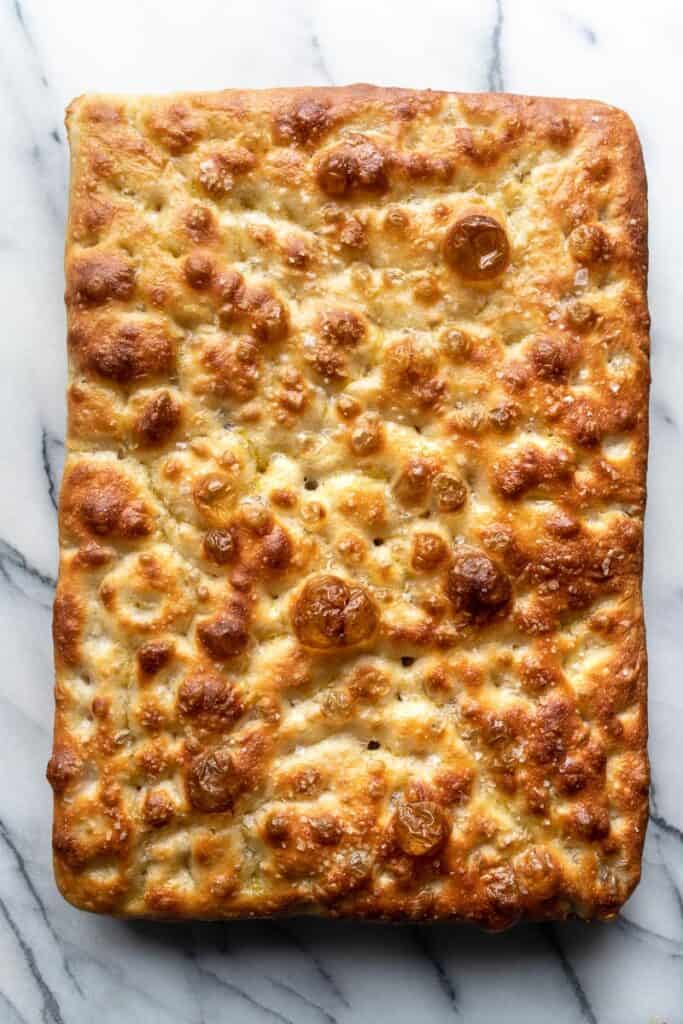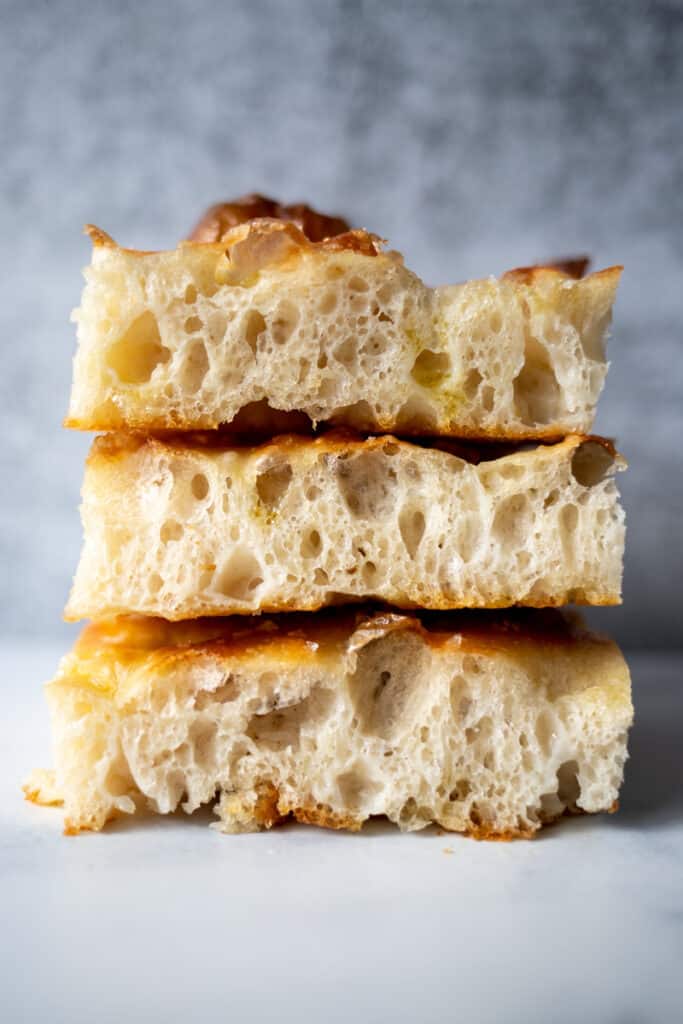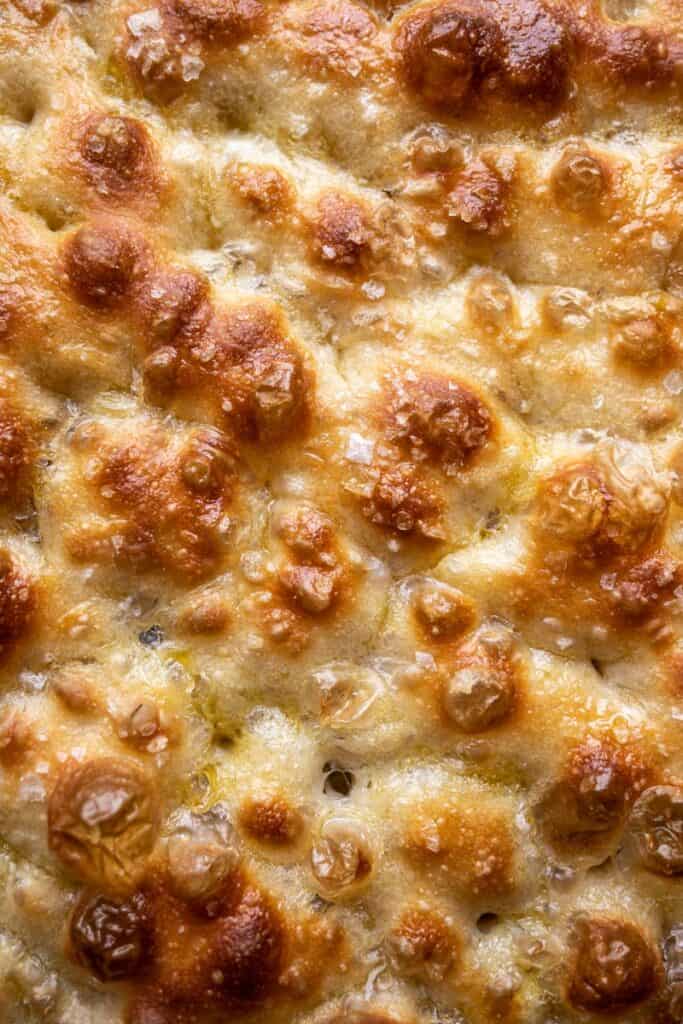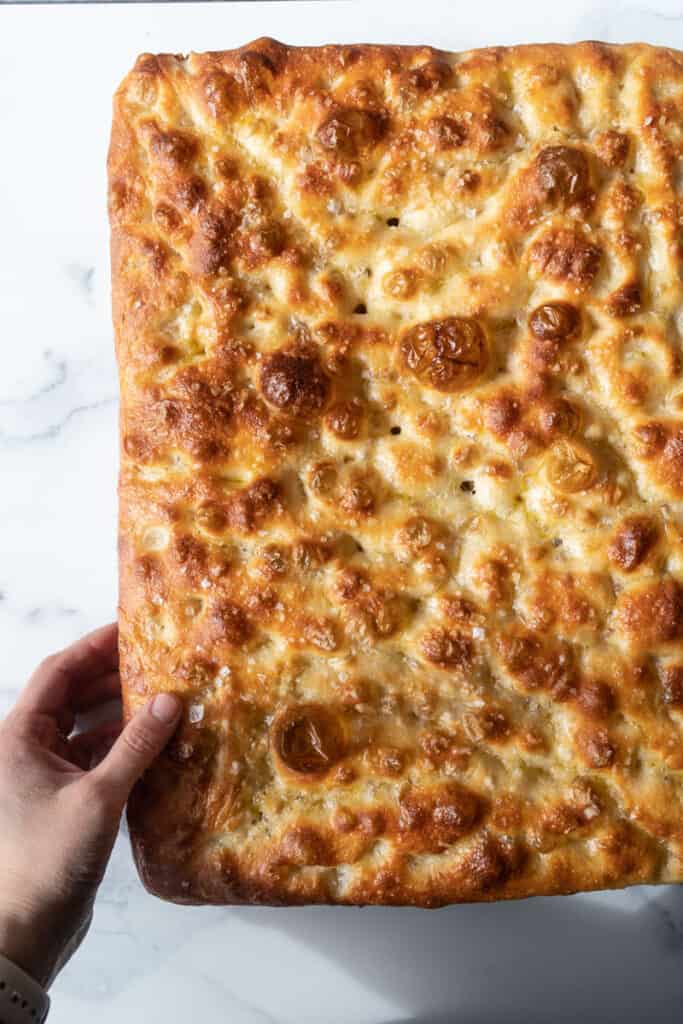Focaccia. Is there any other bread we’d rather sink our teeth into? Answer: not many. Perfect to enjoy with dinner, as a vessel for sandwiches, or even just a killer snack, this is it– the perfect focaccia recipe.

This focaccia recipe is the result of nearly one dozen rounds of testing with inspiration from many sources. From Il Massimo Della Focaccia and Il Frantoio in Monterosso of The Cinque Terre, we learned the true beauty of deep and seemingly endless, oil-filled dimples. From Samin Nosrat we learned the value and necessity of a salty brine. From Claire Saffitz we learned that bread flour is the best flour. And from testing and retesting we learned that there really is no better focaccia than one that sits in the refrigerator overnight for a slow, cold rise (more on this later).

What is Focaccia?
Focaccia is a bread that originated in Italy and is made with a few simple ingredients: flour, salt, yeast, water, and extra virgin olive oil. Our version of focaccia is chewy and almost crispy on the outside, soft and pillowy on the inside, and is laced with a generous amount of both extra virgin olive oil and salt. If you love bread and you love olive oil, there is no better baked item in this world.
There are many variations of focaccia in Italy and throughout the world, but our favorite version is nice and bubbly with a beautiful, photogenic crumb, dimples hydrated with oil, and plenty of flaky salt sprinkled on top. Focaccia is typically the result of a high hydration dough, meaning the bread has a high water to flour ratio, which gives it a beautiful, hole-y crumb that tastes just as good as it looks.

Pronunciation
First thing’s first– you need to know how to pronounce our favorite Italian bread. Say it with me: foh-kah-chuh. Not foh-kah-shuh. Focaccia. Foh-kah-chuh. Onward.
How To Make Focaccia
Making homemade focaccia is simple. Yes, you read that correctly– it is not difficult to make homemade focaccia that rivals the focaccia you’ve enjoyed in restaurants or even in Italy, but there are three main secrets to success: 1) you must allow enough time for the bread to rise in three separate phases (there aren’t any quick fixes– great focaccia requires time to develop amazing flavor), 2) you must brine your focaccia prior to dimpling and baking it (don’t worry, this part is easy), and finally 3) you can’t be afraid of using a generous amount of extra virgin olive oil.
Now that we’ve laid the ground rules, here’s a quick overview of how to make focaccia:
1– Make the dough. Start by whisking together the dry ingredients including the bread flour, 2 Tablespoons of the kosher salt, and yeast, and then add the water and incorporate with one hand. Squeeze the dough with your mixing hand, ensuring all of the flour has been absorbed and all of the ingredients are incorporated.
2- Complete the first rise. Generously oil a large bowl or food container with 2 Tablespoons of extra virgin olive oil and then transfer the dough to your oiled bowl or container. Drizzle the top of the dough with an additional tablespoon of olive oil. Cover with a lid or plastic wrap and let it sit at room temperature until it doubles in size, typically 2-3 hours (or longer if your house runs cool).
Tip #1: take a picture of the dough before you let it rise so you can know with confidence once it has truly doubled. Tip #2: use a food container for the most accurate read on dough size, thanks to its non-tapered sides and volume markers.
3- Shape and stretch the dough. After the dough has doubled in size, it’s time to transfer it to a standard half sheet pan. Oil the pan with another 2 Tablespoons of extra virgin olive oil and empty the dough onto the oiled pan. Carefully stretch the dough with your hands, pressing down and outward as you make contact with it. You can also carefully place the dough directly on the back of your hands and stretch outward using your knuckles. After you’ve stretched the dough as much as possible, let it rest for 10-15 minutes. Stretch the dough again, this time making sure the edges reach the parameter of the half sheet pan.
4– Let the dough cold rise. Place a baking sheet cover (these are our favorite) on top of the half sheet pan, or oil a sheet or two of plastic wrap with cooking spray and cover the pan tightly. Place the dough in the refrigerator for 8-72 hours. Allowing your dough to rise for several hours at a cold temperature (otherwise known as a “cold ferment”) helps develop amazing flavor and creates a wonderfully chewy, and airy crumb. This is a method we also use in one of our favorite pizza dough recipes.
5- Complete the third rise. After the cold ferment has been completed, it’s time to bring your dough to room temperature. This is also the best time to begin preheating your oven (set it to 450°F). Let the dough warm for 60-90 minutes at room temperature, until it’s nearly doubled in size and has reached the height of the half sheet pan (it’s okay if it’s a little taller than the pan, too).
6- Brine and dimple. Create a simple brine by combining 1/2 cup of water and 1 1/2 teaspoons of kosher salt until the salt is dissolved. Pour 2 tablespoons of extra virgin olive oil over the top of the dough, and using oiled hands, spread the oil until it’s evenly distributed over the surface of the dough. Pour 2/3rds of the brine on top of the oiled dough as evenly as you can. Now for the fun part– using your index, middle, and ring fingers, press deeply into the surface of the oiled and brined dough, all over until the focaccia is covered in dimples. If any dimples are void of brine, fill them in with the reserved brine.
7– Sprinkle with salt and bake. Grab your favorite finishing salt (we love flake salt or fleur de sel), and sprinkle the salt generously all over the dimpled dough. Bake the focaccia for 25-35 minutes, until it’s a beautiful deep, golden brown on both the top and bottom of the focaccia. Remove from oven, and using a heavy metal spatula, release the focaccia from any portions that may have stuck from the half sheet pan on the bottom or sides, and transfer to a cooling rack to completely cool (don’t skip this step- if you leave the focaccia in the pan you risk the bottom becoming soggy). Brush the focaccia with an additional 1-2 Tablespoons of extra virgin olive oil. Once cooled, slice the bread and dive headfirst into focaccia heaven.

What To Eat With Focaccia
Focaccia is incredibly versatile and can be eaten in a variety of ways. The most purist and uncomplicated way, of course, is on its own. This should be your first experience with focaccia– an unadulterated moment of salty, oily, gastronomic bliss.
We also love focaccia served with lunch or dinner, particularly as a side for any pasta dish, perfect for mopping up any leftover sauces. Focaccia makes a fantastic base for sandwiches, and we highly recommend using prosciutto, mortadella, or salami paired with cheese and a simple spread like an olive tapenade, artichoke cream, or even a drizzle of olive oil and red wine vinegar. Focaccia is also a great vessel for breakfast sandwiches- serve it with eggs and bacon or ham for the most wonderful, savory start to your day.
Sample Timeline
5 pm: make dough and first rise
8 pm: shape and stretch the dough
8:30 pm-8:30 am: cold ferment (second rise)
8:30 am-9:30/10:00 am: third rise
10:00 am: brine, dimple, and bake
Want More Focaccia?
- Sourdough Focaccia Recipe (uses sourdough starter)
- Table X Focaccia Recipe (uses commercial yeast & sourdough starter)
Perfect Focaccia
Ingredients
Focaccia
- 6.5 cups bread flour (910 grams)
- 2 Tablespoons Diamond kosher salt*
- 1 1/2 teaspoons instant yeast
- 3 cups room temperature water (708 grams)
- 1/2 cup extra virgin olive oil, plus more as needed
- flake salt or fleur de sel for finishing
Brine
- 1 1/2 teaspoons Diamond kosher salt
- 1/2 cup water
Instructions
First Rise
- In a large bowl mix together the bread flour, 2 Tablespoons of the kosher salt, and instant yeast with a whisk. Add the water and using one hand, mix together the dough and the flour until all of the flour is completely absorbed into the dough. Squeeze the dough with your mixing hand to ensure everything is incorporated and there are no lumps of flour. Oil a large bowl or food container with 2 Tablespoons of the extra virgin olive oil and transfer the dough to the oiled bowl or container. Drizzle roughly 1 Tablespoon of the oil on top of the dough and cover tightly with a lid or plastic wrap. Allow the dough to rise until doubled in size.**
Stretch The Dough
- Oil a standard rimmed 18×13" half sheet pan with 2 Tablespoons of extra virgin olive oil, making sure the entire surface and sides are coated with the oil. Empty the dough onto the oiled pan, and carefully stretch the dough to the edges of the pan. You can do this by gently pressing your hands down and away in opposite directions as you press down onto the dough, or you can carefully place the dough on back of your hands (directly onto your knuckles) and slowly move your hands apart from each other as you stretch the dough. Once the dough cannot be stretched anymore, allow it to rest for 10-15 minutes. Once rested, carefully stretch the dough until it reaches the perimeter of the pan on all four sides.
Second Rise (Cold)
- Cover the pan with a plastic baking sheet cover or wrap tightly with plastic wrap (spray the inside surfaces of the plastic wrap with cooking spray to avoid sticking). Place in the refrigerator for a minimum of 8 hours and up to 72 hours.
Third Rise
- After the dough has risen for 8-72 hours, preheat oven to 450°F and remove the pan from the refrigerator. Let the dough warm and rise until nearly doubled in size and it has at least reached the top of the half sheet pan (about 60-90 minutes).
Brine & Dimple
- Make a simple brine by dissolving 1 1/2 teaspoons of the kosher salt into 1/2 cup of water and set aside. Coat the dough with 2 Tablespoons of extra virgin olive oil and spread across the surface with oiled hands. Pour 2/3rds of the brine on top of the oiled dough as evenly as you can. Using your index, middle, and ring fingers on both hands, press deeply into the surface of the oiled and brined dough, creating dimples over the entire pan of dough (don't be afraid to press deep to the bottom surface of the pan). If any dimples are void of brine, fill them in with the reserved brine.
Bake The Focaccia
- Sprinkle the dimpled dough liberally with finishing salt and place in the oven to bake for 25-35 minutes, until a beautiful deep golden brown color. Once finished, remove from the oven and using a sturdy metal spatula, release any areas on the bottom or side of the pan that may have stuck. Carefully transfer the focaccia to a cooling rack. Brush the top of the focaccia with 1-2 Tablespoons of extra virgin olive oil. Allow focaccia to cool completely and slice with a serrated knife before serving.
Equipment
- 1 standard rimmed 18×13" half sheet pan
- 1 food container or dough rising bucket (minimum 3 quarts), optional, but helpful
Notes
Did you make this recipe?
Tag @femalefoodie so we can see what you’re cooking!


Hilary
This recipe is amazing! We all loved it. Thanks for sharing!
Brooke Eliason
Thank you so much Hilary!
Melissa Bennion
Seriously tastes just like Italy’s. I went to Italy the first time 6 months ago and had their focaccia. I was in love! Couldn’t forget it. This recipe is legit. Make it and follow her suggestions. You won’t be disappointed.
Brooke Eliason
Thank you Melissa- such a huge compliment! Glad you liked it. 🙂
Hailey
Chewy, soft inside, flavorful, so easy to make. A fantastic recipe I can make over and over again!
Brooke Eliason
So happy to hear it- thanks so much Hailey!
Hannah
This focaccia is so so so good. So good. The recipe is easy to follow and so simple. Don’t skimp on the salt flakes on top! I added fresh rosemary on top before the bake and it was *chef’s kiss. I will make it again and make a couple batches because ours was gone in minutes!
Brooke Eliason
Thank you, Hannah! The rosemary sounds AMAZING- we can’t wait to add that to ours next.
Michelle
So amazing! I am a recipe follower (vs winging it) and so appreciate the precise steps to follow and it turned out perfect! I bake a lot (mostly sweet treats) and my family said it was the best thing I ever made and they are critics (especially of bread)!
Brooke Eliason
Thank you so much Michelle! We are so happy that the instructions were helpful.
Haley
I’m not a baker, so bread intimidates me. After seeing Brooke post about this, I couldn’t get it out of my head, so I went for it. So simple! Simple ingredients, simple directions and the hardest thing about it is waiting for the rising because you just want to eat it! We ate it as a snack and used it for sandwiches. I even taught my kids the correct way to say it (how do I unlearn a life of calling it fuh-ka-SHa?)
Brooke Eliason
Thank you so much Haley!!! So happy to hear that this bread recipe was manageable for you. And we won’t judge you if you call it fuh-ka-sha 😀 Happy baking!
Samantha Olsen
Perfect recipe! Brilliant directions. Turns out incredible. The whole family loved it. Best focaccia I’ve ever had. I loved making this!!
Brooke Eliason
Such a thoughtful comment. Thank you so much Samantha!
Jessica
So delicious. Everyone couldn’t stop raving about how delicious it was. Definitely making this again!
Brooke Eliason
Thank you so much Jessica!
Cydney
This recipe is a keeper! First time making focaccia. This is not a hard recipe. Just make sure you give yourself the necessary time (12 or so hours minimum) to get it done. The small effort yields great results. The bread has great texture! The olive oil and salt perfectly balance this delicious bread! Make this!
Brooke Eliason
Thank you Cydney! So happy to hear that you liked it. 🙂
Katie
I’m excited to give this a try – hoping to come close to some wonderful focaccia I had on a recent trip to Europe. Do you need to make any modifications or take anything into consideration if you want to add toppings of any kind? (Tomato, olives, etc)
Brooke Eliason
Hi Katie! Can’t wait to hear what you think! As long as you aren’t using an overwhelming amount of toppings, if you’re throwing in tomatoes, olives, etc to the top it shouldn’t alter the recipe. Enjoy 🙂
Elisabeth Kensinger
I have made this a couple of times and adore it. I’m doing a lot of baking with my sourdough starter right now and I’m wondering about the advisability of subbing some of the flour and water for sourdough?
Brooke Eliason
Thanks so much! I am hoping to create a sourdough version soon- I will likely start by swapping a cup of ripe sourdough starter with the yeast and go from there. Obviously the rise times will be different but I’ll for sure shard any updates here when I make them. 🙂
Caitlin
This focaccia truly is perfection! Super simple and always so incredibly good! I have made it several times and it never disappoints.
Brooke Eliason
Thank you so much Caitlin!